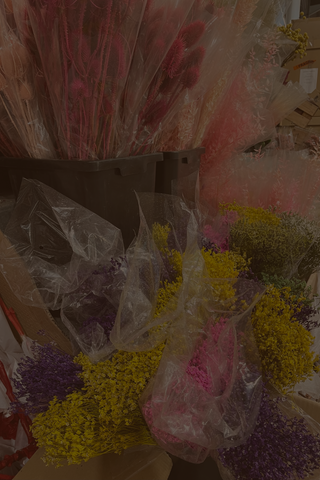When people ask me about AMBLE & TWINE, and when I explain that I work with dried flowers, I am always very, very careful with this explanation… real dried flowers, I usually say. I have to. Because when we talk about dried flowers these days, I know what people might be thinking.
While natural dried flowers are popular, the extensive range of chemically preserved flowers {bleached, synthetically dyed, altered, and imported} are, unfortunately, far more prevalent.
They can be found everywhere… filling boutiques, storefront windows, gracing checkout counters, reception desks, and restaurant tables. They fill offices and homes all around the world; they are available to buy in homewares stores, in flower shops, in online stores, and they are abundant across social media accounts, where they are used by floral designers, shopkeepers, wedding florists, and interior stylists.
This is an upsetting topic for me to discuss, and one that I actually try to avoid, for the most part, because I find it so troubling. I try to share my voice on this topic through my creations and show how beautiful and abundant mother nature is, all on her own. Every colour and texture imaginable already exist naturally in flowers, and the amazing quality and longevity that untreated dried flowers have is second to nome.
I also try to show that by connecting with natural, local flowers we are given an incredible opportunity to learn about our environment and appreciate the natural world for what it is. And perhaps, find the desire to nurture it and protect it. For many people, flowers offer one of the last remaining ways that we can connect with the real, seasonal world around us. I feel very strongly that we should not let a fad take that away from us.
In this Journal post, I am going to try to explain what preserved flowers are and present some concerns that I have. I will share reasons why we should all take notice of this unnecessary floral trend, and think about the impact that it is having on each other, the environment, and our quality of life. Coming from a place of kindness and concern, I hope that this will shine a little bit of light on the issue, especially for those who are unfamiliar with preserved flowers.


WHAT ARE PRESERVED FLOWERS?
To start with, I think that there may be some confusion around what these materials actually are. There was a time, when it was quite popular for florists to do a little bit of DIY preserving themselves, such as dipping some stems in glycerine, or dying a few stems with some food colouring. And so, I wonder, when someone sees a neon pink bunch of billy buttons, if they think that their florist was just having a wild night of creativity? No! This is not the case!
The chemically preserved flower industry is a big one, making up a good chunk of the multi-billion-dollar worldwide floral industry, which is why we need to talk about it. For the most part, these materials are mass produced in Asia, where production and labour is cheap, and flowers can be grown in large factory farms, preserved and processed quickly and distributed in vast quantities.
Shipping containers are sent all around the world, every day, filling markets with so many chemically preserved, plastic-wrapped materials, that in many flower shops they outnumber the domestically grown flowers that are available for sale. In Australia, most of this material does include an origin label when it is purchased in its original packaging, which is usually China. Once it is removed from this packaging, they can sometimes be harder to identify. Preserved flowers are used to create bouquets, wreaths, arrangements, and floral installations.

I think that preserved flowers can best be described as some sort of taxidermy. What starts with a living, breathing thing - is transformed into something zombie-like - resembling its original form, but eerily different. First, the plant material is drenched in bleaching agents and dehydrating alcohol solutions in order to strip all of the life and colour from the plant. Once there is nothing left but a brittle, empty shell, the material is embalmed… it is soaked in glycerine and preservatives, pumping the shell back up with an array of softening agents and additional chemicals to prevent mould and deter rats, mice, and cockroaches from nibbling. Then they are dyed. Some are also donned with a sprinkling of plastic glitter. The materials are sprayed with artificial fragrance, in an attempt to mask the toxic odours, and then they are fumigated for export - ensuring that not a single shred of life remains on the product.

All preserved flowers have been so heavily altered that they eventually must go to landfill. Nothing can be recycled or composted. That is a mind-boggling amount of unnecessary material that is going straight into the red bin regularly. And we’re talking about flowers here, not life-saving medical equipment. In terms of longevity, preserved flowers don’t actually last. They get coated with dust that sticks on and cannot be washed or shaken off, so their lifespan is cut short and they are binned.

I can’t really say when, exactly, these products started to emerge, but I do know that the first time I saw them was about 4-5 years ago, when the most on-trend colours were pale peach and ‘bohemian’ beige and white. I started to notice everlasting wreaths and dried flower arrangements that were made up entirely of these colours – all bleached grasses and pastel-dyed billy buttons and bunny tails. And so, perhaps it is the colour availability that has made preserved flowers so appealing?
Similarly, at the time I am writing this, I find that big, bold, neon colours are trending – and so again, I wonder if it is appealing to some that there are so many preserved materials that have all of these colours available in vast quantities. Perhaps neon-blue hydrangeas and fluorescent-pink grasses are somehow seen as artistic or in-style because they fit the current colour trend?

Maybe colour is to blame, and maybe the truth is that a lot of people just really like them. That, in a way, is easier for me to understand. There are a lot of people that prefer a can of artificially flavoured soda over some natural fruit juice.
Maybe food presents a really great analogy for this issue. I think of preserved flowers much like a ‘Fruit Drink’ that has a big fat label on the front saying ‘Real Fruit,’ but then as you look at the ingredients on the back, you can clearly see that the food is made overseas, with preservatives, sweeteners, artificial flavours and colours… and 1% fruit. I think that this is what preserved flowers are. They are 1% flower.
Maybe preserved flower bouquets should be labelled and sold with an ‘ingredients’ label, so people understand what they are buying, and so for those who might not know what real flowers actually look like {and who may be interested in a healthier choice} are not led to believe that they are buying something that actually occurs naturally on this planet.

THE UNSEEN DAMAGE
The most disturbing fact of all, I believe, is the unseen damage that this trend has. This is what is most upsetting to me. Bringing flowers into our homes and spaces is one of the last remaining ways that humans can connect with the natural world. Flowers should be something that foster a deeper connection to nature, that fill us with curiosity and leave us wanting more… maybe a desire to find flowers in the wild and develop an interest in the conservation of their habitat, or maybe to grow them at home and spend a bit more time in the garden.
Flowers should be a sensory experience, we should enjoy the natural feel and scent of them, whether they are fresh or dried. Preserved flowers take all of this away.
There is nothing to ponder about a fluorescent-pink billy button, because it does not exist. There is nothing that a neon-blue hydrangea can teach you about the seasons, because it does not exist. There is nothing to see but bleach and dye, nothing to feel but a slimy residue, and there is nothing to smell except chemicals. There is nothing that holds any wonder or meaning, nothing to talk about as it fills homes with emptiness, nothing that can teach us - or our children - about nature and our environment.
 I have honestly struggled, through all of my attempts to research the source of preserved flowers, to find many facts at all about where exactly they come from, or any articles about how exactly they are produced. So, this post really just scratches at the surface.
I have honestly struggled, through all of my attempts to research the source of preserved flowers, to find many facts at all about where exactly they come from, or any articles about how exactly they are produced. So, this post really just scratches at the surface.
WHAT CAN WE DO?
- Ask questions! – Ask your florist where their flowers are from before purchasing. Ask for natural, Australian grown {not 'sourced'} flowers and nothing preserved. Remember that there is nothing wrong with asking questions. The good news is that there are many amazing florists that do not use any imported or preserved flowers in their work.
- Be careful when shopping for dried flowers. How sad for me to say that! But if you are looking at them in person or online – look closely. Do they look natural? Do they look dry and crispy? Do they have an origin label? Do they look like something you can compost?
- Be wary of mixed arrangements. Chemically preserved flowers can often be found mixed in with naturally dried flowers and fresh flowers. This is very troubling because it makes purchasing very confusing. Again, asking questions is always a good idea.
- Buy fresh, local flowers and dry them yourself. I am so excited to share more about this wonderful {and simple} process with you soon! You can have a look at all of the flowers that I dry myself here.
I hope that this is helpful to someone out there. Thank you again for being here.
With complete kindness and concern,
Elizabeth xx



Lidia
Thank you for this information I had no idea. I buy flowers from a local store the flowers are imported from South America, but I don’t have information about flowers from Sout America. This is something I will have to find out and going forward I will be on the lookout for organic local flowers.
Kindeng
Thanks for sharing this article, Elizabeth. I don’t like such instant way of drying flower either. I prefer to press my flowers by myself.
Cheers,
Kindeng
Kindeng
Thanks for sharing this article, Elizabeth. I don’t like such instant way of drying flower either. I prefer to press my flowers by myself.
Cheers,
Kindeng
Will
Thanks Elizabeth!
I so agree, all of that artificial treatment leaves someone with no sensory experience of true dried flowers at all. Looking forward to the next one as we get into drying our own more seriously.